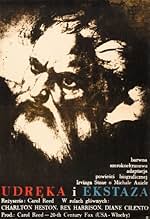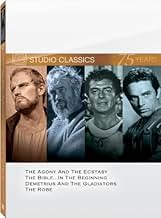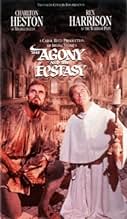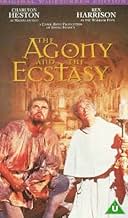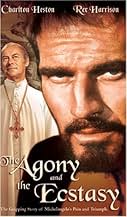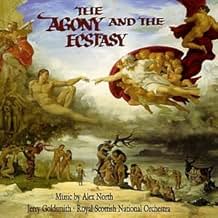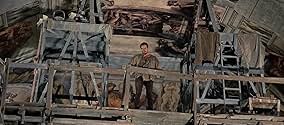NOTE IMDb
7,2/10
8,6 k
MA NOTE
Michel-Ange est chargé par le pape Jules II de peindre les fresques du plafond de la Chapelle Sixtine. Le peintre génial supporte mal le comportement despotique du pape. L'affrontement entre... Tout lireMichel-Ange est chargé par le pape Jules II de peindre les fresques du plafond de la Chapelle Sixtine. Le peintre génial supporte mal le comportement despotique du pape. L'affrontement entre les deux grands hommes est inévitable.Michel-Ange est chargé par le pape Jules II de peindre les fresques du plafond de la Chapelle Sixtine. Le peintre génial supporte mal le comportement despotique du pape. L'affrontement entre les deux grands hommes est inévitable.
- Réalisation
- Scénario
- Casting principal
- Nommé pour 5 Oscars
- 3 victoires et 9 nominations au total
Fortunato Arena
- Pope's Bodyguard
- (non crédité)
Lars Bloch
- Baron Von Silenen
- (non crédité)
Angelo Boscariol
- Papal Guard
- (non crédité)
Calisto Calisti
- Physician
- (non crédité)
Amerigo Castrighella
- Quarry cart assistant
- (non crédité)
Anita Ceccotti
- Woman Under the Chapel
- (non crédité)
Enrico Chiappafreddo
- Tavern Customer
- (non crédité)
Avis à la une
"The Agony and the Ecstasy" is the story of Michaelangelo and his painting of the Sistine Chapel at the behest of Pope Julius II, a warrior and Patron of the Arts.
But it's really about so much more - the connection between art and the artist, faith, will, and the quest for perfection. Most of all, it's about the complicated relationship of two determined men, Michaelangelo and Pope Julius, which is adversarial and even violent.
The color and scenery in this film are truly beautiful, but I'd love to see a restored print, as I imagine the colors would even be richer.
Charlton Heston is a convincing and strong Michelangelo in what may be his best performance. It's buoyed by the magnificent work of Rex Harrison as Julius II. The two spark one another, and the result is an exciting screen teaming. There is hatred, resentment, a battle of wills, love and admiration between them, the agony and ecstasy of connecting with another, as Diane Cilento says in the film. She plays a woman in love with Michaelangelo. He explains that he cannot love her because of the commitment he has made to his true love, his art. The book hints at Michaelangelo's homosexuality, and it's covered with one line. After Michaelangelo says that he cannot match her feelings, he looks at a sketch of a nude man. "And it's not that either," he says.
Many scenes stick out. The somewhat hokey one in the mountains, when Michaelangelo looks at the heavens and receives his inspiration is nevertheless a gorgeous scene; the incredible scene when Michaelangelo discovers the Pope alone at night with a candle studying the ceiling is perhaps the best, as Michaelangelo explains his concept of God and faith. And the last scene between the two men is unforgettable.
There is a documentary about Michaelangelo and his work before the movie begins. A magnificent film. Don't miss it.
But it's really about so much more - the connection between art and the artist, faith, will, and the quest for perfection. Most of all, it's about the complicated relationship of two determined men, Michaelangelo and Pope Julius, which is adversarial and even violent.
The color and scenery in this film are truly beautiful, but I'd love to see a restored print, as I imagine the colors would even be richer.
Charlton Heston is a convincing and strong Michelangelo in what may be his best performance. It's buoyed by the magnificent work of Rex Harrison as Julius II. The two spark one another, and the result is an exciting screen teaming. There is hatred, resentment, a battle of wills, love and admiration between them, the agony and ecstasy of connecting with another, as Diane Cilento says in the film. She plays a woman in love with Michaelangelo. He explains that he cannot love her because of the commitment he has made to his true love, his art. The book hints at Michaelangelo's homosexuality, and it's covered with one line. After Michaelangelo says that he cannot match her feelings, he looks at a sketch of a nude man. "And it's not that either," he says.
Many scenes stick out. The somewhat hokey one in the mountains, when Michaelangelo looks at the heavens and receives his inspiration is nevertheless a gorgeous scene; the incredible scene when Michaelangelo discovers the Pope alone at night with a candle studying the ceiling is perhaps the best, as Michaelangelo explains his concept of God and faith. And the last scene between the two men is unforgettable.
There is a documentary about Michaelangelo and his work before the movie begins. A magnificent film. Don't miss it.
When you think about it, making a movie about artistry is pretty hard. Painting, writing, sculpting, music, whatever, it's not easy to make the act very interesting--painting is painstaking, it takes a long time. But in this movie, they succeed. Not just making a movie, but making an epic, a massive movie out of an act of creation, is a tough thing to do. But they really do succeed. At the heart of the movie isn't really the act of creation, or the passion for it, or even the ceiling itself--it's the adversarial relationship between Rex Harrison (Pope Julius II) and Charlton Heston (Michaelangelo).
It's certainly not that passion and creation are not here, it's just that they enrich the story about two men and their relationship. When Julius comes into the chapel in the middle of the night, and Michaelangelo is invariably there, there's a bond, even with silent incipient tension.
Heston is of course the only person for this role, as epics go, he's the best. For some reason he manages not to be overcome by the massive scale of these sorts of movies--something that happens to almost everyone else (look at Sinatra and Cary Grant in "the Pride and the Passion", they are totally lost in the grande scale, and they're the incomparable Grant and the larger than life Sinatra, not much more to be said there). Heston makes a solid tortured artist and Rex Harrison is quite wonderful as the Pope. He communicates the strength and intelligence of a Pope who loves art but must go to battle to preserve all that he holds dear. There's a scene when the Pope wants people to see the half completed chapel, since he has grown impatient with the time and when Michaelangelo bitterly objects, Harrison explodes with anger--extremely effective. When Harrison passed, it was truly a loss to movies.
There are flaws, no question, and it's not Heston's best work, course, once you've done Ben Hur and the Ten Commandments, nothing else is going to be your best work. The subplot with the sort of love interest is pretty silly, and it goes on a bit too long. The earnestness of the faith in the church, the sincerity of Heston when he says "Holiness" to the pope, a man that drives him crazy, is poignant. His faith is deep, almost as if he derives his love of art from a love of God. There are even some nice moments of levity as when a spattered Michaelangelo spits out a gob of paint and it lands near a watching Julius; or when the Pope creates a cardinal out of teen for payment in order to keep up the painting.
When it comes to big movies, this definitely lays with a handful of others that will never be surpassed--Titanic tried to be this kind of movie, and proves that even with $200 million and all the nifty gizmos of the modern age, it's very difficult to do; c'mon, Rex Harrison and Charlton Heston compared to Leo DeCaprio and Billy Zane--not much of a contest there.
See the movie, forgive it its flaws and appreciate the richness and nuance of the relationship between Pope and Artist.
It's certainly not that passion and creation are not here, it's just that they enrich the story about two men and their relationship. When Julius comes into the chapel in the middle of the night, and Michaelangelo is invariably there, there's a bond, even with silent incipient tension.
Heston is of course the only person for this role, as epics go, he's the best. For some reason he manages not to be overcome by the massive scale of these sorts of movies--something that happens to almost everyone else (look at Sinatra and Cary Grant in "the Pride and the Passion", they are totally lost in the grande scale, and they're the incomparable Grant and the larger than life Sinatra, not much more to be said there). Heston makes a solid tortured artist and Rex Harrison is quite wonderful as the Pope. He communicates the strength and intelligence of a Pope who loves art but must go to battle to preserve all that he holds dear. There's a scene when the Pope wants people to see the half completed chapel, since he has grown impatient with the time and when Michaelangelo bitterly objects, Harrison explodes with anger--extremely effective. When Harrison passed, it was truly a loss to movies.
There are flaws, no question, and it's not Heston's best work, course, once you've done Ben Hur and the Ten Commandments, nothing else is going to be your best work. The subplot with the sort of love interest is pretty silly, and it goes on a bit too long. The earnestness of the faith in the church, the sincerity of Heston when he says "Holiness" to the pope, a man that drives him crazy, is poignant. His faith is deep, almost as if he derives his love of art from a love of God. There are even some nice moments of levity as when a spattered Michaelangelo spits out a gob of paint and it lands near a watching Julius; or when the Pope creates a cardinal out of teen for payment in order to keep up the painting.
When it comes to big movies, this definitely lays with a handful of others that will never be surpassed--Titanic tried to be this kind of movie, and proves that even with $200 million and all the nifty gizmos of the modern age, it's very difficult to do; c'mon, Rex Harrison and Charlton Heston compared to Leo DeCaprio and Billy Zane--not much of a contest there.
See the movie, forgive it its flaws and appreciate the richness and nuance of the relationship between Pope and Artist.
The picture deals with Michelangelo or Michael Angel (Charlton Heston) who is working on the Carrara's marble creating sculptures and he is then ordered by Pope Julius II (Rex Harrison) the painting of as called Sistine chapel (that's why it was built by Pope Sisto) . Meanwhile , they'll develop various relationships with other Renaissance's important people . The film is correctly based on historical deeds and appearing famous roles , such as : Raphael (Tomas Milian) who shows up painting the ¨Athenas' school¨, Bramante (Harry Andrews) builder of the Vatican dome that hold his name , Girlandaio , Florence Medicis' descendants (Diane Cilento and Adolfo Celi) and duke of Urbin (Alberto Lupo). Besides , the film paces itself the confrontation between Julius II troops and the French/German army for the possession of the Pope's states . There are epic and impressive battles where the Pope himself fights enemies . The motion picture describes specially the creation of the enormous paintings on the ceiling and the difficulties that Michael Angel is suffering to achieve the immortal legacy . The Pope Julio II will also assign him the realization of his tomb .
The feature movie obtained a limited success and had a moderated box-office ; however , being nowadays better valued than the past . First-range acting by the two main actors : Charlton Heston and Rex Harrison , both of whom are magnificent . However , Rex Harrison did not get along with Charlton Heston at all during shooting ; in fact , twelve years later, while filming as secondary actors ¨Crossed swords¨ (1977) directed by Richard Fleischer , Rex avoided him utterly . Leon Shamroy's cinematography is rousing , the colorful paintings are glowing and brilliant ; spectacularly showing Bible's scenes at the Sistine Chapel . Alex North musical score is riveting (like ¨Spartacus¨ who he equally composed) . The sets are overwhelming and breathtaking , they were stunningly designed by production designer John De Cuir . In addition , evocative as well as adequate costumes by Oscarized Vittorio Nino Novarese . Carol Reed production and direction were excellent , he'd got much experience through a long career and had directed other classic movies (The third man) . Rating: Very good , above average and well worth seeing.
The feature movie obtained a limited success and had a moderated box-office ; however , being nowadays better valued than the past . First-range acting by the two main actors : Charlton Heston and Rex Harrison , both of whom are magnificent . However , Rex Harrison did not get along with Charlton Heston at all during shooting ; in fact , twelve years later, while filming as secondary actors ¨Crossed swords¨ (1977) directed by Richard Fleischer , Rex avoided him utterly . Leon Shamroy's cinematography is rousing , the colorful paintings are glowing and brilliant ; spectacularly showing Bible's scenes at the Sistine Chapel . Alex North musical score is riveting (like ¨Spartacus¨ who he equally composed) . The sets are overwhelming and breathtaking , they were stunningly designed by production designer John De Cuir . In addition , evocative as well as adequate costumes by Oscarized Vittorio Nino Novarese . Carol Reed production and direction were excellent , he'd got much experience through a long career and had directed other classic movies (The third man) . Rating: Very good , above average and well worth seeing.
I like historical films. Recently I watched three historical films all made in the early 1960s. These are 'El Cid', 'The Spartacus' and 'The Agony and The Ecstasy'. Of the three, I rate The Agony and the Ecstasy as the best. This film is based on the eponymous novel written by Irving Stone. I had read the book nearly a decade back and it was nice to see the film finally. The film is about the circumstances under which Michelangelo came to compose his famous frescoes in the Sistine Chapel of Rome in the 16th century. The Sistine fresco, the 'creation of man' has become almost an emblem for the artist. But not many know that Michelangelo painted the Sistine frescoes reluctantly, only because he was forced to do so by his patron, Pope Julius II. The film is about the war of wits between these two great men Pope Julius II is a warrior pope, a worldly Pope. His concern is to protect the papal states from being over run by warring European powers. For this he is willing to take up arms. The pope knows that the posterity wont remember him for his spiritual prowess or leadership. Therefore he want to leave great works of art as his legacy. He therefore hires Michelangelo to paint the ceiling of the Sistine Chapel. The artist is not very keen on painting and considers sculpture to be his true calling. He is also not willing to conform to the prevailing canons of artistic excellence. He feels constrained by the limits of time and money that is set. All the great moments of the film occur when the Pope and the Artist clash. It is a clash of ideas and world views: (1) Whether sculpture is a superior form of art as compared to painting; (2) Whether it is appropriate depict biblical figures in their raw humanity; (3) Whether it is moral for a man of god to take arms for his principles and so on. For me the finest scene in the film is where the Pope and the Cardinals come to see the frescoes and judge it as lacking in good taste. The Artist is forced to give a strong rebuttal and in the process he expounds the humanist philosophy of art. Shot in beautiful Technicolor, the film still looks spectacular. It is a visual and intellectual treat.
This is a fascinating, colorful and very-well made film that looks like an epic and is in fact an intelligent drama about sculptor-painter- architect-poet Michelangelo Buonarrotti. Here portrayed by the much taller Charlton Heston, and admirably, he is presented as a man who want only to create beauty, a man without "people skills" or interest in much of anything else--not women, nor war not the dynastic dreams of men--only the Renaissance idea of utilizing one's abilities. He even pays attention to religion only because the world interests him, and he equates his heaven with what men can achieve--and Earth with the same sort of place he expects to find as an afterlife. Carol Reed directed and produced this fascinating look at the Renaissance, with its warrior priests, its worldly dreamers and its subtle change toward a politics of gunpowder, secular pursuits and worldly morality. Philp Dunne, author of "David and Bathsheba" wrote this thoughtful spectacle film as well. In the cast besides Heston are Rex Harrison as Pope Julius, close-fisted patron, admirer and nemesis, Harry Andrews as his rival Bramante, Diane Cilento as the woman who would like to love him, Alberto Lupo, Adolfo Celli, Fausto Tozzi and a narration by Marvin Miller. The opportunity to see the real landscapes in which Michelangelo was born, worked and became inspired is a wonderful one for the viewer; the entire Carrara marble quarry section is stunningly beautiful. The film has battle scenes able done by Robert D. Webb, Leon Shamroy's cinematography, a prelude by Jerrald Goldsmith and sterling music by Alex North, production design by John Cuir and Jack Martin Smith and memorable costumes by Vittorio Nino Novarese. The basic thrust of the storyline is twofold; against the wars conducted by vigorous and all-too-worldly Pope Julius, the war to win secular hegemony for his Papal rule, the counter-current is Michelangelo's desire to further his career in Rome by obtaining a commission from the Pope. He does, an assignment to refurbish the Sistine Chapel for him. But after an attempt at some saints, he leaves Rome, and flees to his beloved Carrara. There, surrounded by mountains, he has a vision at sunset and suddenly knows what he must do. Obtaining Julius's reluctant permission, he sets to work covering that modest ceiling with tremendous figures, a bearded Jehovah, a recumbent Adam touched to life by a divine spark, the world's most famous fresco painted from a homemade scaffolding; in spite of illness, missed meals, filth, deprivation, cold, an injury that nearly costs him his eye and more, including the Pope's indifference to his intense passion for his art, Michelangelo endures. "When will you make an end?" Julius cries. "When I have done," the artist insists. And at the end, Julius, beaten on the field of battle, admits he may also have been wrong about the ceiling...that his fostering of Michelangelo's work may be the most important thing he has ever done. Of course the puritans of the era object to the nakedness the artist has depicted, but Michelangelo says he painted people as God made them. The movie, based on the biography "The Agony and the Ecstacy" by Irving Stone here concentrates on a seminal moment in the great artist's career. He may be a sculptor as he insists; but after seeing this moving and fascinating film, no one can doubt that he is also a stubborn and single-minded man--and a painter of genius. Most underrated; often fascinating fictionalized biography. Heston and Harrison are good, everyone else good as well. Worth seeing many times, if only for Dunne's dialogue and the scenery.
Le saviez-vous
- AnecdotesThe book on which this movie is based covers the entire life of Michelangelo Buonarroti. This movie based on a single chapter. One of the shortest, if not the shortest, in the entire book.
- GaffesAs shown in the movie, Michelangelo created a flat wooden platform on brackets built out from holes in the wall, high up near the top of the windows. But contrary to what is depicted in the film, he did not lie on this scaffolding while he painted, but painted from a standing position.
- ConnexionsEdited from Prologue: The Artist Who Did Not Want to Paint (1965)
Meilleurs choix
Connectez-vous pour évaluer et suivre la liste de favoris afin de recevoir des recommandations personnalisées
- How long is The Agony and the Ecstasy?Alimenté par Alexa
Détails
- Date de sortie
- Pays d’origine
- Langues
- Aussi connu sous le nom de
- La agonía y el éxtasis
- Lieux de tournage
- Piazza del Popolo, Todi, Perugia, Umbria, Italie(St. Peter's Square scene)
- Société de production
- Voir plus de crédits d'entreprise sur IMDbPro
Box-office
- Budget
- 10 000 000 $US (estimé)
- Durée
- 2h 18min(138 min)
- Couleur
- Rapport de forme
- 2.20 : 1
Contribuer à cette page
Suggérer une modification ou ajouter du contenu manquant


